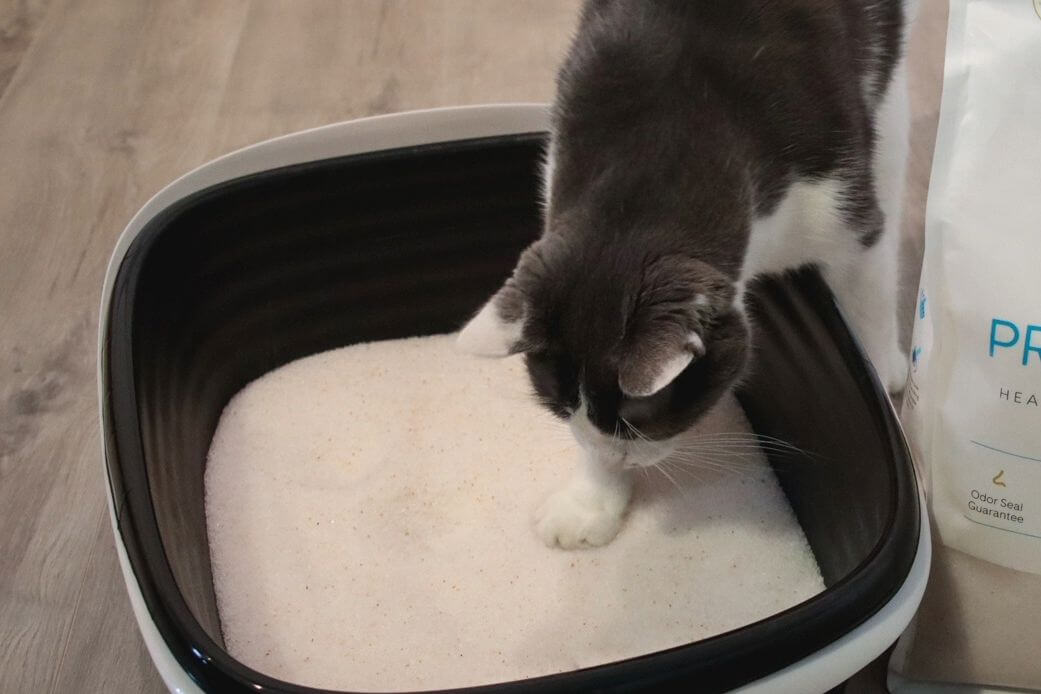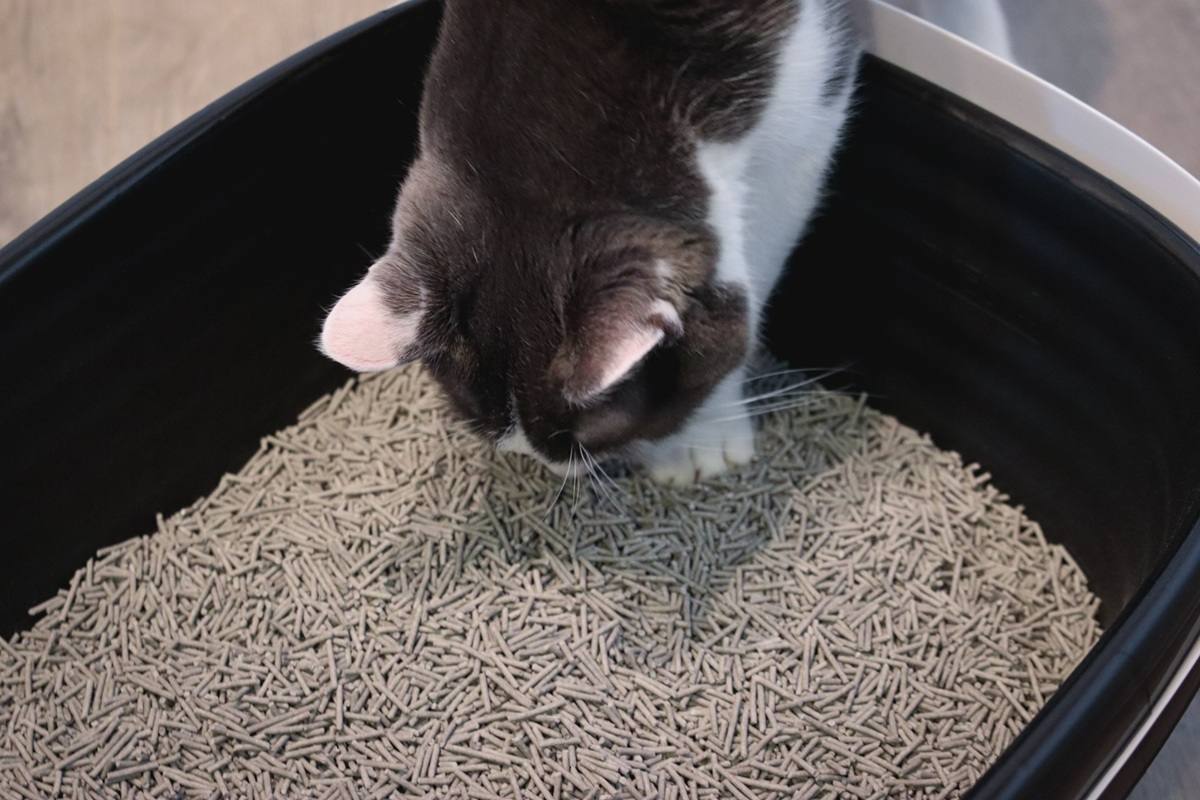
Kate Barrington / Cats.com
If your cat companion is a house cat or uses a litter box, you’re bound to have seen and heard them scratching the side with their claws at times. And when you’re deep in conversation or watching television, the noise can seem to go on forever!
So, why do cats scratch in their litter box? Is this pesky habit normal cat behavior? And if it isn’t, what can cat owners do about it?
Why Do Cats Scratch the Sides of the Litter Box Before Pooping?
If you’ve paid some attention when your cat is using their litter box, you might notice them scratching around in the cat litter. You might see them pacing around, and scratching the sides of a litter box before they pee or poop. This is their way of finding the perfect spot for their deposit.
Cats will dig a hole to make it easier for them to bury their scent afterward. It might seem like they change their mind a few times before settling on a place to toilet. This might be because they’re avoiding another cat’s scent or dirty cat litter. Of course, while they’re doing all this digging and scratching, they’re bound to catch the side of the litter box sometimes.
Why Do Cats Scratch the Sides of the Litter Box After Pooping?
It’s normal cat instinct to bury urine and feces after they’ve used the litter box. This is to prevent them from being located by predators and because they’re very clean animals. It’s also how they leave their scent markings because your cat’s paws have scent glands.
Wild cats, adult cats, and even kittens dig and bury their urine and feces. By scratching the sides of the litter box, they’re making sure they reach the furthest edge of the tray to grab as much cat litter as possible.
What Does It Mean if Your Cat Scratches the Litter Box Excessively?

Cats often scratch the sides and bottom of the litter box while digging a hole for their “deposit.” Kirsten McCarthy / Cats.com
Scratching the side of the litter box is perfectly normal cat behavior. However, if it seems excessive or your feline friend seems to be spending a long time digging around.
In that case, they might not be satisfied with their kitty toilet. If this is the case, it’s time to do some detective work to find out what’s bothering them.
They Don’t Like the Cat Litter
Cats can be very fussy, especially concerning their litter box. So, if you’re noticing your kitty seems unable to find a suitable spot to do their business, it might mean they disapprove of your choice of litter.
Thankfully, there are plenty of options, from gravel, clay, and sand to woodchips, clumping, and non-clumping. Once you find out which your fussy feline likes best, you might find they’re more efficient at using the litter box!
There’s Not Enough Litter

Your cat may love their litter, but are you using enough? Ensuring the right amount can improve odor control and comfort. Kirsten McCarthy / Cats.com
Perhaps you’re already using the type of cat litter that your kitty likes, but you’re not using enough of it. I get it; the costs of owning a pet add up, and money is tight for many people now.
But, don’t be tempted to use less litter. if you create a deeper layer of cat litter, you’ll make it easier for your cat to bury their poop, and you might find that your cat stops scratching the litter box so much.
Their Litter Box Is Too Small
We all want to feel relaxed and comfortable when we go to the toilet, and your cat is no different. If your purry pal feels cramped and restricted because their litter box is too small, they might struggle to settle down to use it.
If you choose a bigger one that gives them more space, they might get on with the job quickly and do less scratching about!
They Don’t Like the Type of Litter Box
You might find that your cat prefers more privacy, so they might feel more comfortable using a litter box with a lid. On the other hand, some cats find that an enclosed litter box cramps their style. So, it’s all about personal preference for the types of cat litter boxes!
The Litter Box Isn’t in the Right Place
You wouldn’t want to use the bathroom with an audience, nor does your cat. Cats usually prefer their litter box to be in a quiet, private location, away from the hustle and bustle of family life. If your cat’s litter box is on the main thoroughfare through the house, try moving it to a quieter spot.
The Litter Box Isn’t Clean

Because “old” feces is more likely to contain the oocysts that cause toxoplasmosis, at-risk people should avoid scooping their cat’s litter box. Mallory Crusta / Cats.com
Cats love cleanliness! If their litter box isn’t clean, they’ll be reluctant to use it. This can mean they spend what seems like hours scuffling around in the cat litter, scratching the sides, trying to find a clean-ish spot.
If your cat’s excessive litter box digging is bothering you, try cleaning it more often. However, ensure you use cleaning products that don’t smell too strongly, as this could also offend your finicky feline.
They Don’t Like Sharing
Many humans prefer to use their own bathroom rather than a public toilet. After all, it’s not so pleasant to consider that so many others have used the same toilet you’re using. Well, cats think in a similar way. They don’t like to share their litter box.
This doesn’t just mean keeping their litter box clean; it also means making sure you have the correct number of litter trays for the number of cats in your household. A good guideline is to have one more litter box than the number of cats you have. This will prevent competition and bullying and make toileting easier for your feline family.
They Have Health Issues
Suppose your cat is frequently back and forth to the tray and passes only tiny amounts of urine. In that case, they might have a urinary tract infection or cystitis. You should contact your vet immediately if you think this might be the case. A blocked bladder, where no urine can be passed, is a serious emergency that mainly affects male cats.
If your cat has a blocked bladder, they may also seem lethargic, grumpy, and in pain. Constipation might also mean they dig around in their tray more than usual and don’t produce anything. Both of these conditions require veterinary care.
Conclusion

If your cat is scratching excessively in the litter tray, try the tips above and consult a vet if needed. Kirsten McCarthy / Cats.com
It can be frustrating when you’re trying to concentrate on something, and all you can hear is your cat clawing at the sides of the litter box. However, it’s important to remember that it’s usually normal cat behavior.
On the other hand, if your cat’s routine changes or if you think your cat is scratching in the tray excessively, you should try some of the above tips and seek veterinary advice if needed.
Frequently Asked Questions
Why do cats scratch the wall near their litter box?
Cats like to dig around in the cat litter before they use the litter box. Once they've found the perfect place to poop, they dig a hole, do their business, then bury it. It's all part of normal cat behavior, territory marking, and cleanliness. However, it's normal for cats to scratch the walls near the litter box and the sides of the litter box. This just means they're making sure they're using all the available cat litter.
Why does my cat dig in the litter box for so long?
If your cat is doing excessive scratching in the litter box, it could mean they're not happy with the litter box setup. The solution could be as simple as cleaning it more often or using more cat litter. But you might also need to consider relocating the litter box, using different cat litter, or changing the style of the litter box entirely.
How often do you need to change cat litter?
You should be scooping contaminated cat litter, litter clumps, and poop from the litter box twice a day or more frequently. A complete change of the cat litter should be performed regularly when the litter is dirty or smelly. The exact frequency depends on your cat litter since clumping cat litter makes spot cleaning more effective.






